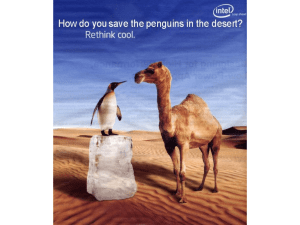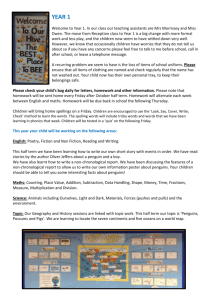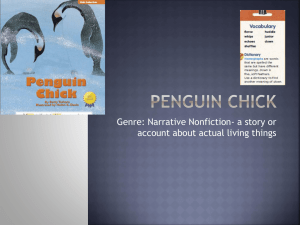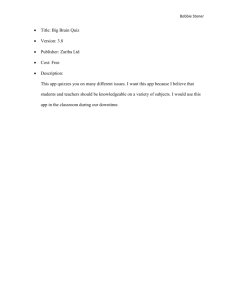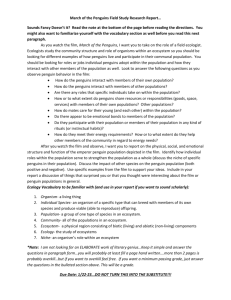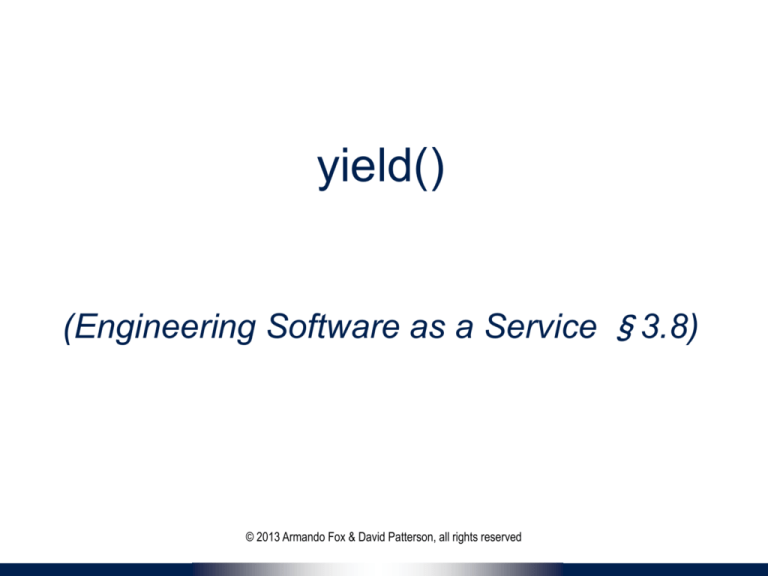
yield()
(Engineering Software as a Service §3.8)
© 2013 Armando Fox & David Patterson, all rights reserved
Inelegant, This
ArrayList aList;
Iterator it = aList.iterator();
while (it.hasNext()) {
Object element = it.getNext();
// do some stuff with element
}
• Goal of the code: do stuff with elements of
aList
• But iterator logic is all jumbled up with the
code
Blocks (Anonymous λ)
(map '(lambda (x) (+ x 2)) mylist )
mylist.map { |x| x+2 }
(filter '(lambda (x) (even? x)) mylist)
mylist.select do |x| ; x.even? ; end
(map
'(lambda (x) (+ x 2))
(filter '(lambda (x) (even? x)) mylist))
mylist.select {|x| x.even?}.map {|x| x+2 }
Turning Iterators Inside-Out
• Java:
– You hand me each element of a collection in turn
– I will do some stuff
– Then I will ask you if there’s any more left
• Ruby:
– Here is some code to apply to every element of
the collection
– You manage iteration or data structure traversal
– Give me each element to do stuff to
• Let’s do an example...
http://pastebin.com/T3JhV7Bk
Iterators are Just One Nifty Use of
yield
# in File class
def open(filename)
...open a file...
end
def close
...close a file...
end
# in some other library
def open(filename)
...before code...
yield file_descriptor
...after code...
end
# in your code
def do_everything
f = File.open("foo")
my_custom_stuff(f)
f.close()
end
# in your code
def do_everything
File.open("foo") do |f|
my_custom_stuff(f)
end
end
Without yield(): expose 2
calls in other library
With yield(): expose 1 call in
other library
Blocks are Closures
• A closure is the set of all variable bindings
you can “see” at a given point in time
– In Scheme, it’s called an environment
• Blocks are closures: they carry their
environment around with them
http://pastebin.com/zQPh70NJ
• Result: blocks can help reuse by separating
what to do from where & when to do it
– We’ll see various examples in Rails
7
In Ruby, every _____ accepts a(n)
_____, but not vice-versa.
☐ yield() statement; iterator
☐
☐ block; iterator
☐ iterator; block
8
9
Summary
• Duck typing encourages behavior reuse
– “mix-in” a module and rely on “everything is a
method call—do you respond to this method?”
• Blocks and iterators
– Blocks are anonymous lambdas that carry their
environment around with them
– Allow “sending code to where an object is”
rather than passing an object to the code
– Iterators are an important special use case
Summary (cont.)
12
Intro to RSpec & Unit Tests
(Engineering Software as a Service §8.1)
© 2013 Armando Fox & David Patterson, all rights reserved
Debugging is
twice as hard as
writing the code
in the first place.
Therefore, if you
write the code as
cleverly as
possible, you are,
by definition, not
smart enough to
debug it.
Testing can
never
demonstrate
absence of
the _____
errors in
software, only
presence
their _______
Testing Today
• Before
– developers finish code, some ad-hoc testing
– “toss over the wall to Quality Assurance [QA]”
– QA staff manually poke at software
• Today/Agile
– testing is part of every Agile iteration
– developers test their own code
– testing tools & processes highly automated
– QA/testing group improves testability & tools
Testing Today
• Before
– developers finish code, some ad-hoc testing
– “toss over the wall to Quality Assurance [QA]”
Software
Qualitypoke
is the
result of a
– QA
people manually
at software
good process, rather than the
• Today/Agile
oneAgile
specific
–responsibility
testing is part of of
every
iterationgroup
– developers responsible for testing own code
– testing tools & processes highly automated;
– QA/testing group improves testability & tools
BDD+TDD: The Big Picture
• Behavior-Driven Design (BDD)
– develop user stories (the features you wish you
had) to describe how app will work
– via Cucumber, user stories become
acceptance tests and integration tests
• Test-Driven Development (TDD)
– step definitions for a new story, may require
new code to be written
– TDD says: write unit & functional tests for that
code first, before the code itself
– that is: write tests for the code you wish you had
Cucumber & RSpec
• Cucumber
Failing (red)
describes behavior
Cucumber step
via features &
scenarios (behavior
Failing (red) RSpec test
driven design)
• RSpec tests
individual modules Passing (green) RSpec test
that contribute to
those behaviors
Passing (green)
(test driven
Cucumber step
development)
19
20
Which are true about BDD & TDD:
a) requirements drive the implementation
b) they can be used only in Agile development
c) they embrace & deal with change
☐Only (a)
☐
☐ Only (a) & (c)
☐ (a), (b) and (c)
21
22
FIRST, TDD, and Getting
Started With Rspec
(Engineering Software as a Service §8.2)
© 2013 Armando Fox & David Patterson, all rights reserved
Unit Tests Should Be FIRST
• Fast
• Independent
• Repeatable
• Self-checking
• Timely
Unit Tests Should Be FIRST
• Fast: run (subset of) tests quickly (since
you’ll be running them all the time)
• Independent: no tests depend on others, so
can run any subset in any order
• Repeatable: run N times, get same result (to
help isolate bugs and enable automation)
• Self-checking: test can automatically detect
if passed (no human checking of output)
• Timely: written about the same time as code
under test (with TDD, written first!)
RSpec, a Domain-Specific
Language for Testing
• DSL: small programming language that
simpifies one task at expense of generality
– Examples: regex, SQL
• RSpec tests are called specs or examples
http://pastebin.com/LKTK36Pb
• Run the tests in one file: rspec filename
– Red failing, Green passing, Yellow pending
• Much better: running autotest
27
Which kinds of code can be tested Repeatably
and Independently?
a) Code that relies on randomness (e.g. shuffling
a deck of cards)
b) Code that relies on time of day (e.g. run
backups every Sunday at midnight)
☐Only (a)
☐
☐ Both (a) and (b)
☐ Neither (a) nor (b)
28
29
The Web as a Client-Server
System; TCP/IP Intro
(Engineering Software as a Service
§2.1–2.2)
© 2013 Armando Fox & David Patterson, all rights reserved
30
Chapter 2 Overview
31
Web at 100,000 Feet
• The web is a client/server architecture
• It is fundamentally request/reply oriented
Web browser
Internet
Web site
Client-Server vs. Peer-to-Peer
C
C
S
C
P
P
P
P
C
P
P
• High-level architecture of the overall system
– Soon we’ll talk about architecture “inside” boxes
• Client & server each specialized for their tasks
– Client: ask questions on behalf of users
– Server: wait for & respond to questions, serve many clients
• Design Patterns capture common structural solutions to
recurring problems
– Client-Server is an architectural pattern
33
Nuts and Bolts: TCP/IP Protocols
• IP (Internet Protocol) address identifies a physical network
interface with four octets, e.g. 128.32.244.172
– Special address 127.0.0.1 is “this computer”, named localhost,
even if not connected to the Internet!
• TCP/IP (Transmission Control Protocol/Internet Protocol)
– IP: no-guarantee, best-effort service that delivers packets from one IP
address to another
– TCP: make IP reliable by detecting “dropped” packets, data arriving out of
order, transmission errors, slow networks, etc., and respond appropriately
– TCP ports allow multiple TCP apps on same computer
• Vint Cerf & Bob Kahn: 2004 Turing Award for
Internet architecture & protocols, incl. TCP/IP
GET /bears/
HTTP/0.9 200 OK
GET /bears/
HTTP/0.9 200 OK
Web at 100,000 Feet
• The web is a client/server architecture
• It is fundamentally request/reply oriented
• Domain Name System (DNS) is another kind of
server that maps names to IP addresses
Web browser
Web site
DNS server
Now That We’re Talking, What Do We Say?
Hypertext Transfer Protocol (HTTP)
• an ASCII-based request/reply protocol for
transferring information on the Web
• HTTP request includes:
– request method (GET, POST, etc.)
– Uniform Resource Identifier (URI)
– HTTP protocol version understood by the client
– headers—extra info regarding transfer request
HTTP status codes:
• HTTP response from server
2xx — all is well
– Protocol version & Status code =>
3xx — resource moved
– Response headers
4xx — access problem
– Response body
5xx — server error
37
Assuming “>” means “relies on”,
which statement is NOT correct:
☐ DNS > IP
☐
☐ TCP > DNS
☐ All the above are correct
38
39
Cookies
• Observation: HTTP is stateless
• Early Web 1.0 problem: how to guide a user
“through” a flow of pages?
– use IP address to identify returning user?
✖ public computers, users sharing single IP
– embed per-user junk into URI query string?
✖ breaks caching
• Quickly superseded by cookies
– Watch: screencast.saasbook.info
• Rails manages tamper-evident cookies for you
Uses of Cookies
• Most sites quickly realized that the per-user
state could be used for lots of things:
– customization (“My Yahoo”)
– click tracking/flow tracking
– authentication (logged in or not)
– Which of these could be implemented on the
client side? Which ones shouldn’t be and why?
• A golden rule: don’t trust the client—cookies
must be tamper-evident
42
A ____ can create and modify cookies;
the ____ is responsible for including the
correct cookie with each request
☐ Browser; SaaS app
☐
☐ HTTP request; browser
☐ SaaS app; HTTP response
43
44
3-Tier Shared-Nothing
Architecture & Scaling
(Engineering Software as a Service §2.4)
© 2013 Armando Fox & David Patterson, all rights reserved
45
Chapter 2 Overview
46
Dynamic Content Generation
• In Olden Days, most web pages were
(collections of) plain old files – static content
• But most interesting Web 1.0/e-commerce
sites run a program to generate each “page”
• Originally: templates with embedded code
“snippets”
• Eventually, code became “tail that wagged
the dog” and moved out of the Web server
Sites That are Really Programs
(SaaS)
• How do you:
– “map” URI to correct program
& function?
– pass arguments?
– invoke program on server?
– handle persistent storage?
– handle cookies?
– handle errors?
– package output back to user?
• Frameworks support these
common tasks
Filesystem
or database
your app
persistence
logic (app)
Common Gateway
Interface (CGI)
presentation (Web
server)
client (browser)
Developer Environment vs.
Medium-Scale Deployment
MySQL
file.sqlite3
SQLite
adapter
Rails
library
rack
Webrick
MySQL
adapter
Rails
library
MySQL
adapter
Rails
library
MySQL
adapter
Rails
library
rack
rack
rack
thin
thin
thin
Page
cache
Developer
PostgreSQL
Apache w/mod_rails
+ caching mode
Medium-scale deployment
Database
cache
“Dynos”
running
apps
HTTP servers &
static asset caches
Large-scale curated
deployment, e.g. Heroku
“Shared Nothing”
50
Sharding vs. Replication
• Partition data across
independent “shards”?
+ Scales great
– Bad when operations touch >1
table
– Example use: user profile
• Replicate all data
everywhere?
+ Multi-table queries fast
– Hard to scale: writes must
propagate to all copies =>
temporary inconsistency in data
values
– Example: Facebook wall
posts/“likes”
App
server
App
server
App
server
App
server
App
server
App
server
users A-J
users K-R
users S-Z
All users
All users
All users
51
Summary: Web 1.0 SaaS
• Browser requests web resource (URI) using HTTP
– HTTP is a simple request-reply protocol that relies on TCP/IP
– In SaaS, most URI’s cause a program to be run, rather than a
static file to be fetched
• HTML is used to encode content, CSS to style it visually
• Cookies allow server to track client
–
–
–
–
Browser automatically passes cookie to server on each request
Server may change cookie on each response
Typical usage: cookie includes a handle to server-side information
That’s why some sites don’t work if cookies are completely
disabled
• Frameworks make all these abstractions convenient for
programmers to use, without sweating the details
• ...and help map SaaS to 3-tier, shared-nothing architecture
53
Match the terms:
(a) presentation tier, (b) logic tier,
(c) persistence tier
☐ (a) Apache web server (b) Rack+Rails
(c) Relational database
☐
☐ (a) Microsoft Internet Information Server
(b) Rack+Rails (c) Apache web server
☐ (a) Firefox (b) Microsoft Internet
Information Server (c) MySQL
54
55
HTML+CSS
(Engineering Software as a Service §2.3)
© 2013 Armando Fox & David Patterson, all rights reserved
56
Chapter 2 Overview
57
Text
Introduction
This article is a review of the book
Dietary Preferences of Penguins,
by Alice Jones and Bill Smith. Jones
and Smith's controversial work makes
three hard-to-swallow claims about
penguins:
First, that penguins actually prefer
tropical foods such as bananas and
pineapple to their traditional diet
of fish
Second, that tropical foods give
penguins an odor that makes them
unattractive to their traditional
predators
Hypertext Markup Lang. (HTML)
<h1>Introduction</h1>
<p>
This article is a review of the book
<i>Dietary Preferences of Penguins</i>,
by Alice Jones and Bill Smith. Jones and Smith's
controversial work makes three hard-to-swallow claims
about penguins:
</p>
<ul>
<li>
First, that penguins actually prefer tropical foods
such as bananas and pineapple to their traditional diet
of fish
</li>
<li>
Second, that tropical foods give penguins an odor that
makes them unattractive to their traditional predators
</li>
</ul>
59
Introduction
This article is a review of the book Dietary Preferences of
Penguins, by Alice Jones and Bill Smith. Jones and Smith's
controversial work makes two hard-to-swallow claims about
penguins:
● First, that penguins actually prefer tropical foods such
as bananas and pineapple to their traditional diet of fish
● Second, that tropical foods give penguins an odor that
makes them unattractive to their traditional predators
...
<h1>Introduction</h1>
<p>
This article is a review of the book
<i>Dietary Preferences of Penguins</i>,
by Alice Jones and Bill Smith. Jones
and Smith's controversial work makes
three hard-to-swallow claims about
penguins:
<ul>
<li>
First, ...
HTML
• Document = Hierarchy of elements
– inline (headings, tables, lists, paragraphs)
– embedded (images, JavaScript)
– forms—allow user to submit simple input
(text, radio/check buttons, dropdown
menus...)
• Elements delimited by <tag>....</tag>
– Some have content: <p>Hello world</p>
– Some have attributes: <img
src="http://...">
– id and class attributes useful for styling
Cascading Style Sheets (CSS)
Separate Content from Presentation
• <link rel="stylesheet" href="http://..."/>
(inside <head> element): what stylesheet(s)
go with this HTML page
• HTML id & class attributes important in CSS
– id must be unique within this page
– same class can be attached to many elements
<div id="right" class="content">
<p>
I'm Hank. I teach CSCE606 and do
research in the EDA Lab.
</p>
</div>
CSS Selectors Identify Specific
Elements for Styling
<div class="pageFrame" id="pageHead">
<h1>
Welcome,
<span id="custName">Hank</span>
</h1>
<img src="welcome.jpg" id="welcome"/>
</div>
•
•
•
•
•
•
•
tag name: h1
class name: .pageFrame both of these match the outer
div above. Don’t do this!
element ID: #pageHead
tag name & class: div.pageFrame
tag name & id: img#welcome (usually redundant)
descendant relationship: div .custName
Attributes inherit browser defaults unless overridden
Goal: HTML markup contains no visual styling information
64

